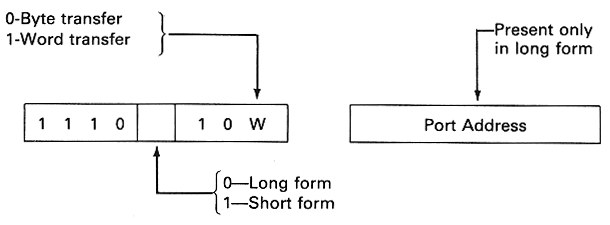
On the 8086, all programmed communications with the I/O ports is done by the IN and OUT instructions defined in Fig. 6-2.
Figure 6-2 IN and OUT instructions
Name Mnemonic and Format Description
Input
Long form, byte IN AL, PORT (AL) <- (PORT)
Long form, word IN AX, PORT (AX) <- (PORT+1:PORT)
Short form, byte IN AL, DX (AL) <- ((DX))
Short form, word IN AX, DX (AX) <- ((DX)+1:(DX))
Output
Long form, byte OUT PORT, AL (PORT) <- (AL)
Long form, word OUT PORT, AX (PORT+1:PORT) <- (AX)
Short form, byte OUT DX, AL ((DX)) <- (AL)
Short form, word OUT DX, AX ((DX)+1:(DX)) <- (AX)
Note: PORT is a constant ranging from 0 to 255
Flags: No flags are affected
Addressing modes: Operands are limited as indicated above.
If the second operand is DX, then there is only one byte in the instruction
and the contents of DX are used as the port address. Unlike memory addressing,
the contents of DX are not modified by any segment register. This allows variable
access to I/O ports in the range 0 to 64K. The machine language code for the IN
instruction is:

Although AL or AX is implied as the first operand in an IN instruction, either AL or AX must be specified so that the assembler can determine the W-bit.
Similar comments apply to the OUT instruction except that for it the port
address is the destination and is therefore indicated by the first operand,
and the second operand is either AL or AX. Its machine code is:

Note that if the long form of the IN or OUT instruction is used the port address must be in the range 0000 to 00FF, but for the short form it can be any address in the range 0000 to FFFF (i.e. any address in the I/O address space). Neither IN nor OUT affects the flags.
The IN instruction may be used to input data from a data buffer register or the status from a status register. The instructions
IN AX, 28H MOV DATA_WORD, AXwould move the word in the ports whose address are 0028 and 0029 to the memory location DATA_WORD.
| PRETHODNA FOLIJA | SADRZAJ | SLEDECA FOLIJA |